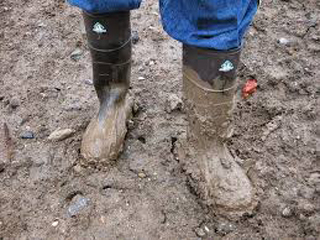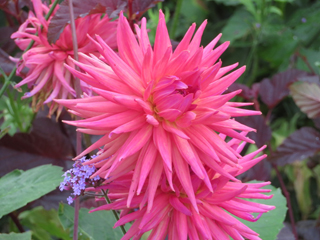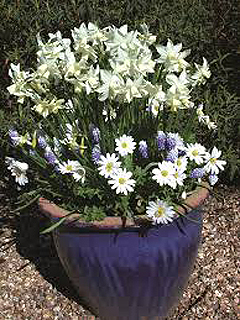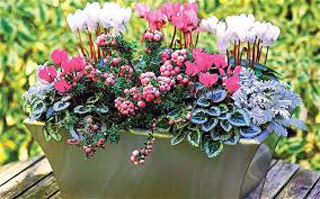 What a difference a few days make. Until recently, we had been enjoying a balmy and dry period lasting for several weeks, and most of the leaves were still firmly affixed to the trees. Now, looking out of the window at driving wind and rain, the lovely autumn leaves are mostly on the ground. Oh well, we suppose we’d been unseasonably lucky up until this last week or two, so we really mustn’t complain. And actually, the dry and warm November has been very helpful in bringing along the winter bedding plants to give us all a bit of colour heading into those slightly doldrum months of winter – see a bit later for some ideas for some winter colour.
What a difference a few days make. Until recently, we had been enjoying a balmy and dry period lasting for several weeks, and most of the leaves were still firmly affixed to the trees. Now, looking out of the window at driving wind and rain, the lovely autumn leaves are mostly on the ground. Oh well, we suppose we’d been unseasonably lucky up until this last week or two, so we really mustn’t complain. And actually, the dry and warm November has been very helpful in bringing along the winter bedding plants to give us all a bit of colour heading into those slightly doldrum months of winter – see a bit later for some ideas for some winter colour.
No matter, there are still jobs you can do in the gaps between the rain showers and while the soil remains reasonably warm. However, we should sound a cautionary note at this point; beware of treading on your garden too much, beds or lawn, at this time of year, especially if it is very wet. By and large, being on troublesome shillit, we Roseland gardeners have very well drained soil. Sometimes this is a boon, sometimes a curse, as anyone who has tried to dig it will tell you. However, at this time of year, your soil structure can easily be damaged by constant footfall, as the soil will compact very easily when wet, and then you will find yourself trying to work something like quick-dried concrete when Spring comes. You can alleviate this by laying boards, if there is somewhere you really must tread, but generally, try and stay off really soggy soil.
 If, like us (OK, like me – Helen. So I’m old-fashioned; who cares?), you are a bit of a fan of the dahlia, you should probably give some thought about how to ensure they survive over the winter. It will be the wet, rather than the cold that does for them here in Cornwall, unless we get an unexpected mini Ice Age, of course. In raised beds, where the drainage is extremely good and they get some winter sun, there should be no problem in leaving them in the ground and for the first time last year, the dahlia fan in our pairing left some in the ground in a well-drained bed, and lo, they came back beautifully.
If, like us (OK, like me – Helen. So I’m old-fashioned; who cares?), you are a bit of a fan of the dahlia, you should probably give some thought about how to ensure they survive over the winter. It will be the wet, rather than the cold that does for them here in Cornwall, unless we get an unexpected mini Ice Age, of course. In raised beds, where the drainage is extremely good and they get some winter sun, there should be no problem in leaving them in the ground and for the first time last year, the dahlia fan in our pairing left some in the ground in a well-drained bed, and lo, they came back beautifully.
However, you may have special varieties, or ones which you just love regardless, which you may not want to risk. Once there is no chance of further decent blooms, and that may have happened already, or the weather becomes too threatening, you can lift it ready for storage. Here’s how we go about that, and it has worked really well for us.
Chop off all the top foliage, leaving a few inches of stalk just for handling purposes. Then, invert it for a week or so in the dry to allow time for any moisture to drain out of the stalk, and for any soil to drop off. Take a bucket or trug or old fat ball container, whatever you have and put in a layer of whatever medium you plan to store it in over the winter. Some people use spent compost, some use sand; we have used vermiculite, simply because we found ourselves with ridiculous amounts of it, and it can be re-used year after year. Whatever you choose, it must be almost dry, to prevent the tubers rotting.
 Over the winter, add a smidgen of water every few weeks, just to stop the tubers desiccating – remember that the tuber is dormant and is not taking up any water or nutrients, so doesn’t need to be watered as if it were growing. That should preserve your tubers over winter, and in late spring, you can start to bring them on in pots, or in May time, once the danger of frost has passed, put them directly into the ground. You can also divide them to give you more plants at this point. Each sub-tuber that has a shoot will form a new plant, so increase your stock this way, or better still, give one to a friend. Plants are made to be shared.
Over the winter, add a smidgen of water every few weeks, just to stop the tubers desiccating – remember that the tuber is dormant and is not taking up any water or nutrients, so doesn’t need to be watered as if it were growing. That should preserve your tubers over winter, and in late spring, you can start to bring them on in pots, or in May time, once the danger of frost has passed, put them directly into the ground. You can also divide them to give you more plants at this point. Each sub-tuber that has a shoot will form a new plant, so increase your stock this way, or better still, give one to a friend. Plants are made to be shared.
There is always an assumption with these gardening columns (guilty, m’lud) that everyone has a large garden with shrub beds, herbaceous borders, copious lawn, and an arboretum. Even in rural and village settings, we realise that many of you garden on a small scale, and have mainly hard surfaces, so here’s something for you as we head into winter.
Even the smallest garden can be brightened with winter pots, and relatively economically. Bedding plants that do well over the winter, and are in all good garden centres at the moment include violas, pansies, panolas (as you might imagine, a hybrid of the two with a more medium-sized flower), cyclamen, early primula, bellis daisy and ivy in a variety of colour ways.
Increasingly, there are also available mini versions of the sorts of shrubs we often see on a larger scale in our gardens such as gaultheria procumbens with its lovely red berries (also known as checkerberries), choisya (Mexican orange blossom), leucothoe (lovely red foliage), conifers for a little height, and even mini-skimmia covered in red berries. Most seasonal. The advantage of these mini shrubs is that they are reasonably priced, and they can form a structure for your pots long after the bedding has done its job and turned its toes up. Alternatively, they can be put into the ground, and over time, will become normal sized shrubs. A great way of starting of small and economically, if you have a bit of patience.
 You can add any or all of the above around the base of shrubs already in pots, to add some seasonal colour, or clear out some summer bedding that has probably done all it is going to this year. To extend the season, and to give you a nice surprise, you can plant bulbs in the pot before you add the bedding. The joy of bulbs – daffs, tulips and even hyacinth do this particularly well – is that we invariably forget we’ve planted them, and it is always a treat when they pop their heads up.
You can add any or all of the above around the base of shrubs already in pots, to add some seasonal colour, or clear out some summer bedding that has probably done all it is going to this year. To extend the season, and to give you a nice surprise, you can plant bulbs in the pot before you add the bedding. The joy of bulbs – daffs, tulips and even hyacinth do this particularly well – is that we invariably forget we’ve planted them, and it is always a treat when they pop their heads up.
It’s the perfect time for tulips and not too late for many of the others, either. A wallflower and tulip combination seems to be very in vogue, but plant according to your own taste. And, when everything has gone over in the distant months, you can either leave the bulbs where they are, or plant them in your garden, for years of continued pleasure.
Well, we hear the sound of the Christmas tree delivery lorry rumbling down the drive, so off we go to get them ready for you early and well-organised purchasers. Oh no, and just behind that is the lorry carrying the blue spruce ready for making Christmas wreaths! How did that happen?! Better be off! Have a lovely Christmas and Happy New Year, if we don’t see you buying your tree and wreath from us, and we’ll see you in 2017!
Sarah Daniel and Helen Robins, Pengelly Garden Centre

